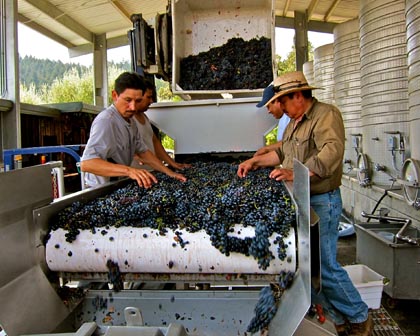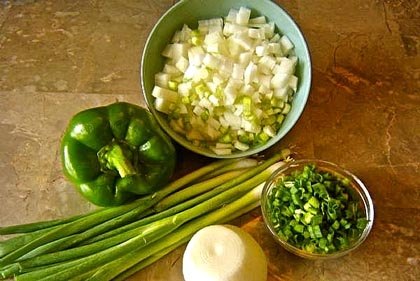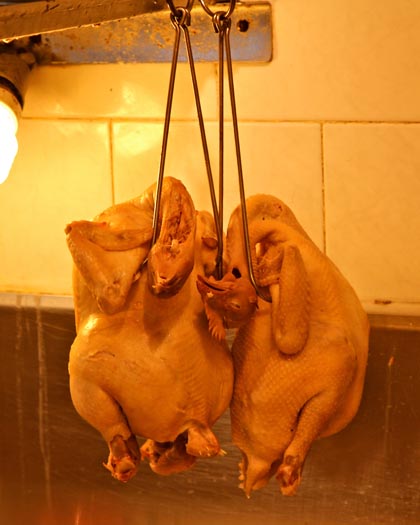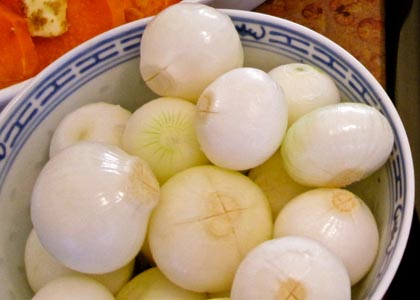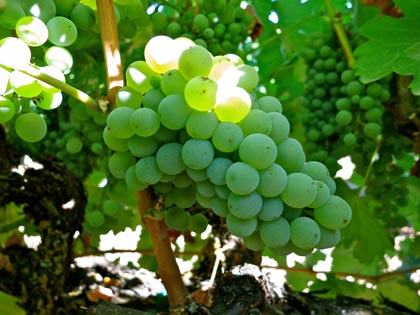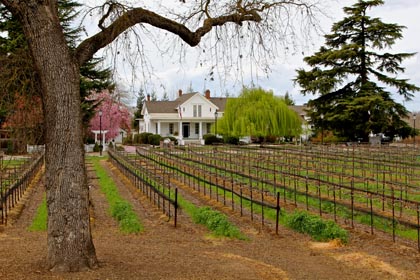Letters from Lodi
An insightful and objective look at viticulture and winemaking from the Lodi
Appellation and the growers and vintners behind these crafts. Told from the
perspective of multi-award winning wine journalist, Randy Caparoso.
Three chicken dishes, endlessly surprising Lodi wine matches
Incoming Lodi Zinfandel: classic match for etoufee style chicken
Let's talk chicken and wine matches. ¿Por qué?
• Chicken is for all-time, anytime, and everywhere – on the menu of three-star restaurants, and on the menu in every home, in every pot or skillet, any night of the week. Paul Bocuse and Julia Child have made chicken a fetish, and so have Colonel Sanders and Lady Gaga (okay – so the latter's, more like a statement).
• Chicken loves company – especially in the way of bottled wine – and picking a good one is not one of life's difficult tasks. The great thing about chicken, of course, is that there are more than 1,001 ways to cook it; and undoubtedly more than 1,001 different wines that go great with it. If heaven is a fine dining restaurant, chicken with wine is undoubtedly a main course.
Chicken must be eaten with wine because that's what elevates it no matter how it's made. Wine is made for chicken like coffee for donuts. No one breathlessly writes home to say, “I found the perfect tea to drink with har yee kai ("beggar's" chicken); or that “the classic drink for Creole fried chicken is Big Gulp.” But they do say that French Burgundy is the natural match for coq au vin; or that Barbera or Sangiovese makes perfect sense with chicken cacciatore.
Speaking of which, let's talk about some of our favorite chicken and Lodi wine matches…
Chicken Cacciatore
Cacciatore – Italy's familial "hunter's" style chicken stew – is cooked either with tomatoes, herbs and white wine, or braised with black olives, bell peppers and anchovy; or often enough, with all of those ingredients at once. You can find many variations of cacciatore, but the classic recipe that we have in mind is that of Marcella Hazan, in her Essentials of Classic Italian Cooking – a simpler yet vivid rendering of chicken, fresh tomatoes and garlic (re Mark’s Daily Apple).
Since this is an Italian style dish, it makes sense to drink Italian style red wines with it – especially those made from grapes like Sangiovese or Barbera – but not for cultural reasons, but rather for sensory ones: it just so happens that Italians like a zesty, tart edge to their wines, and zesty, tart edged red wines happen to go better with dishes accented by the acidity of fresh tomatoes.
Among the many black skinned grapes grown in Lodi, Sangiovese and Barbera naturally ripen with the highest amount of natural acidity – more than that of a Cabernet Sauvignon, Merlot, Zinfandel, Petite Sirah, Carignan or Pinot Noir, and therefore more of a natural for cacciatore style chicken. Yet the beauty of Lodi is that our region's Mediterranean climate is a little more benign and sun kissed than that of Italy, and so Lodi grown Sangioveses and Barberas do not have quite as lean and leathery an edge as Italy's: Lodi's versions are more mildly tart, a little rounder, flush (without being fat) with fruitful (rather than leathery or tarry) aromas and flavors.
Among the more interesting Lodi grown Sangioveses to look for your cacciatore: both Estate Crush (in Downtown Lodi) and Sorelle Winery (estate grown on the southern edge of Lodi) craft Sangioveses as fine as any on the entire West Coast; and Macchia Wines bottles one called Amorous – a little fuller, yet with all the zesty/edgy qualities of the varietal.
Barbera tends to have blacker fruit qualities than Sangiovese (which typically veers towards redder cherry/berried tea-like notes), enhanced by even more natural acidity than the latter. You can never go wrong with Barbera bottlings by Uvaggio, Sorelle, or St. Amant Winery. Typical of the house style, Macchia's Delicious Barbera is more aggressive and oak influenced; while Borra Vineyards produces an honest, rustic style of varietal Barbera, as well as a masterful Heritage Field Blend Red (dominated by zesty Barbera, with smaller portions of Carignan, Petite Sirah and – depending upon the vintage – Alicante Bouschet or Zinfandel).
“Holy Trinity” of onions, bell peppers and celery
Chicken Étoufée
While it sounds French, étoufée style chicken is indubitably all-American: a Cajun-Creole style casserole (also made with shrimp, crawfish or rabbit), that is to say, and an all-time favorite at that. Popular versions of the recipe, such as Paul Prudhomme‘s (we recommend Chef Paul Prudhomme's Louisiana Kitchen), are given great density (but not overly thickened) by the combination of roux (that daunting mixture of flour and fat), a “holy trinity” of onions, bell peppers and celery, plus a dozen or so other spices and seasonings: a mercilessly intense yet complex, layered sensory orchestration. Somewhere beneath the avalanche of sensations in an étoufée is the taste of chicken, which still needs a good bottle of wine to go with its hammer-time flavors.
Chinatown chicken
Étoufée style chicken, of course, likes wines equal to it in depth, heft, and layers of spice. This would mean a good red wine, but not one with a dry, hard tannin taste that would deaden the palate; and the wine that best fits this description is, in fact, good ol' Zinfandel – especially the plump, velvety, peppery-cinnamon-and-clove, kitchen berry jam-like scented style of Zinfandel grown in Lodi.
When you drink Lodi Zinfandel with Cajun-Creole style chicken, in fact, you can't help but think about all those naysayers who complain about California Zinfandel in general being too big, too ripe, too much of something or another – like whiners, not wine lovers. Yet with chicken étoufée, this is precisely the type of wine you need to penetrate the layers, cozy up to the spices, and rustle up the appropriate amount of heft and well ripened fruitiness to mingle with those glorious food sensations. Cabernet Sauvignon, on the other hand, tends to be too harsh in tannin, Pinot Noir and Merlot too wimpy, and white wines and rosés simply overwhelmed by the power of an étoufée. Fruit forward Petite Sirahs might also work; but in the final analysis, Zinfandel really does have the most perfect combination of fruit, spice, perky (without being sharp) acidity, the pliant texture, and full enough body to go toe to toe with the most bodacious étoufée.
The list of Lodi's finest is a long one, of course. If you need a quickie introduction, check out our recent post, Choosing Lodi's top Zinfandels by style – and wham, bam, thank you, Louisiana… for your strangely brewed yet remarkably zin-friendly cuisine.
Coq au Vin Blanc
The most traditional coq au vin is a chicken dish cooked drowning in red wine, with bacon, pearl onions, mushrooms and garlic cloves – wonderful for softer, earthy red wines made from grapes like Pinot Noir and Carignan. But for coq au vin blanc – substituting white wine for red wine in the pot – the better match is undoubtedly a dry yet fruit forward white wine with a moderate amount of acidity (not too high, not too low), with fruit perfumes laced with earthy, stony, or scrubby herb slaked sensations: something Lodi is becoming increasingly known for.
Scored pearl onions
Case in point: in a recent piece on Lodi in summerintheglass.org – a Web site dedicated to the joys of Sauvignon Blanc – Master Sommelier Catherine Fallis wrote about her discovery of the surprising, and underrated, quality of Lodi grown white wines:
As an early student of wine, I learned that California's Central Valley was for almonds, not grapes, unless you were making innocuous bag-in-box swill, not that there is anything wrong with that… But as I dug deeper, taking trips, driving around, visiting the Woodbridge by Robert Mondavi facility and others, and talking with local growers and producers, I discovered that Lodi – with its sunny, Mediterranean climate, cooling Delta breezes, old vine fruit, and a long heritage of growing grapes – was a very special place… Why hadn't anyone been talking about the great wines being made from Lodi fruit?
Indeed, a couple of years ago a very popular British wine journalist named Oz Clarke visited Lodi with a contingent of other Brits, and afterwards wrote of our Delta wine region: "You have very sandy loams for soil… and loam basically means you can't ripen Bordeaux (i.e. red Bordeaux grapes such as Merlot and Cabernet Sauvignon)… but you should be making rosé and looking at white wines."
Hence, Ms. Fallis' own assessment in summerintheglass.org:
What about Sauvignon Blanc? Anyone who has tasted the rich, well-structured LangeTwins Musqué Clone Estate Grown Sauvignon Blanc, or that of (Ironstone‘s) Christine Andrew, Tall House or my go-to weeknight white, Hybrid by Peltier Station, will agree there is a common denominator here of citrus, chalk, banana pudding, musk, slight tropical notes and a glimmer of grassiness. Even the Michael David Sauvignon Blanc, which is a California appellation as it is blended with Lake County fruit, touches on this style.
Lodi grown Sauvignon Blancs, in this sense, are the perfect wines for French inspired coq au vin blanc: they are bone dry and feel light, while bolstered by just the right amount of natural fruit and citrusy acidity to match this mildly earthy, white wine infused dish. In similar fashion, there are a few Chardonnays from Lodi which also have that sense of moderation – not too heavy, not too light, and not overly fruity or oaky – that flow effortlessly with chicken stewed in white wine: the Chardonnays by Watts Winery, The Lucas Winery, and Harney Lane immediately come to mind.
Maybe even better? Dry, light-medium bodied, stony nuanced white wines such as Uvaggio's Vermentino, Borra Vineyards' Artist Series White (a pinpoint, bone dry Kerner/Riesling blend,) or else either the almond scented Roussanne, the silken textured Grenache Blanc, or the wonderfully fragrant, fluid Belle Blanc (Grenache Blanc/Roussanne/Viognier) produced by Lodi's Acquiesce Vineyards. The Uvaggio Vermentino is minimally oaked (just 10% aged in neutral barrels); and the Borra and all the Acquiesce whites, not aged in oak at all – so all you get is the natural taste of fruit, laced with the clean air and mildly earthy tones of Lodi terroir. Pure pleasure!
LangeTwins Family grown Sauvignon Blanc
RIHANA'S COQ AU VIN BLANC
You definitely want to try this dish – an ultimate white wine match – at home. Rihana's recipe calls for a generous amount of white wine, which you can adjust in proportion to the chicken stock – although it is the lustrous, lip smackiing taste of the white wine in the dish that ultimately it with whatever white wine you are drinking:
8 pieces chicken thighs (mostly) and legs (or one 5 lb. chicken, cut in serving pieces)
24-30 pearl onions
Salt and fresh ground black pepper
6 oz. bacon strips or slab, squared or cubed
8 oz. button mushrooms, quartered
1 tbsp. unsalted butter
3 cups dry white wine (inexpensive Sauvignon Blanc or Chardonnay will do; save good stuff to drink)
1 medium yellow onion, quartered
2 stalks celery, quartered
2 medium carrots, quartered
3 cloves garlic, crushed
6-8 springs fresh thyme
1 bay leaf
2 cups chicken stock or broth
Cut off root end of each pearl onion and make an "x" with knife in its place. Bring 2-3 cups water to boil and drop in the onions for 1 minute. Remove onions from pot, allow to cool, and peel (onions should slide right out of skin). Set aside.
Blanch bacon briefly in boiling water; drain, and dice or cube. Fry to render fat; remove meat and set aside, and save fat for frying.
Sprinkle chicken pieces on all sides with salt and ground pepper. Place chicken pieces, a few at a time, into a large (1-2 gallon) sealable plastic bag along with flour; shake to coat chicken completely. Remove chicken from bag, and fry in bacon fat, just until crust is crisp. Set chicken pieces aside.
In same pan, add pearl onions to fat, sprinkle with salt and pepper, sautéing until lightly brown (approximately 8-10 minutes). Remove onions from pan and set aside. Transfer chicken into a 7-8 quart pot (recommended: enameled cast like Le Creuset or cast iron Dutch oven).
Add mushrooms to the same 12-inch sauté pan, adding 1 tbsp. butter if needed, and sauté until liquid is released (approximately 5 minutes). Store onions, mushrooms and bacon in airtight container in the refrigerator until ready to use.
Pour off remaining fat and deglaze pan with approximately 1 cup of wine. Pour this into Dutch oven along with chicken stock, quartered onion, carrots, celery, garlic, thyme and bay leaf. Add all of the remaining wine. Preheat oven to 325° F.
Place chicken in oven and cook for 2 to 2-1/2 hours, or until chicken is tender. Maintain a very gentle simmer and stir occasionally.
Once chicken is done, remove it to a heatproof container, cover, and place in oven to keep warm. Strain the sauce in a sieve and degrease (discard carrots, celery, thyme, garlic and bay leaf). Return the sauce to a pot, place over medium heat, and reduce by 1/3 (depending on how much liquid you began with, this should take 20-45 minutes).
When sauce has thickened, add pearl onions, mushrooms and bacon, and cook another 15 minutes or until heated through. Taste and adjust seasonings if necessary; remove from heat, add the chicken and serve.
Serve from Dutch oven with either long grained white rice or lightly buttered egg noodles. (note: if sauce is not thick enough at the end of reducing, you may add a mixture of equal parts butter and flour kneaded together, starting with 1 tbsp. each; whisk this in the sauce for 4-5 minutes, and repeat if necessary).
Sorelle estate Sangiovese in winter
